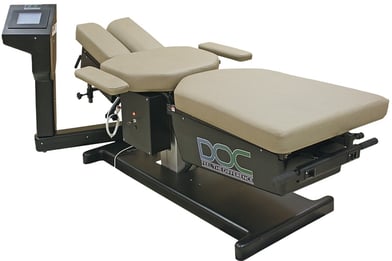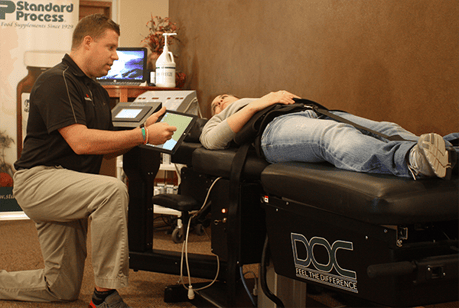Not every chiropractic practice has a decompression table. The big question is: Why? Over the past decade, decompression tables have grown increasingly affordable (from $150K to about $10 to $15K), and the technique itself is growing in popularity.
If you haven’t considered decompression—or even if you’ve tried it—it’s worth taking another look. A majority of chiropractic patients present with lower back and neck pains caused by herniated discs, and decompression provides another option for mechanical treatment that’s effective, and requires less force for both the doctor and the patient.
How Decompression Works
 Decompression occurs under ideal conditions of traction, where positive pressure in the disc change to negative pressure, which creates a “suctioning” action that draws fluid back in the disc. We call this the “decompression” window, and a decompression table helps create that environment within the disc so that it can heal itself.
Decompression occurs under ideal conditions of traction, where positive pressure in the disc change to negative pressure, which creates a “suctioning” action that draws fluid back in the disc. We call this the “decompression” window, and a decompression table helps create that environment within the disc so that it can heal itself.
During treatment, patients decompress for about 20 to 25 minutes to let fluids back into the discs. Used consistently over about 15 to 25 visits, 3 days a week, patients see results that last, when combined with adjunctive therapies such as specific core exercises. (In the past, recommendations were for therapy 5 days a week, with no added exercise, causing frustration when patients would return in six months complaining of the same problem). Building the core helps stabilize the muscles and protect the back from recurring injury.
It’s worthwhile to note that there are two types of back problems: mechanical or chemical. When inflammation causes back pain, these chemical issues are usually best treated by medication such as steroids or pain pills. For mechanical problems such as a herniated disc, medications are only a band-aid. Decompression provides chiropractors with another tool in their toolbox that’s designed specifically to treat mechanical problems in the muscles, joints or discs of the back or neck.
All About the Angles
 While other decompression table models apply pressure to the joints in a linear fashion, PHS Chiropractic’s tables are different. Chiropractic is all about specificity and working with the angles of the vertebral joints. Keeping this in mind, the engineers at PHS designed a decompression table that allows for all degrees of angulation along with rotation.
While other decompression table models apply pressure to the joints in a linear fashion, PHS Chiropractic’s tables are different. Chiropractic is all about specificity and working with the angles of the vertebral joints. Keeping this in mind, the engineers at PHS designed a decompression table that allows for all degrees of angulation along with rotation.
What does this mean for the doctor? Less force on the patient with greater results: Other tables may apply up to 100 lbs. of force, while PHS Chiropractic’s apply only about 45 to 50 lbs. for the same result. This also helps prevent what is termed “decompression hangover”—delayed-onset muscle soreness that patients can experience the next day if too much pressure is applied too fast. Less force during the initial treatment can avoid or dramatically decrease this effect.
Enhancing Your Practice
Finally, consider this: about 80 percent of people will suffer from lower back or neck pain sometime in their lives, most of which is caused by a herniated disc. Decompression therapy is an excellent treatment technique that can help generate referrals from the medical community, enhance your chiropractic practice and expand your patient base.
To find out more about decompression, view this free webinar, “Decompression & Rehabilitation Fundamentals” by Dr. Bryan Hawley. You can also get more information on upcoming certifications and webinars at www.drbryanhawley.com.
Download the Benefits of Spinal Decompression Therapy eBook!


